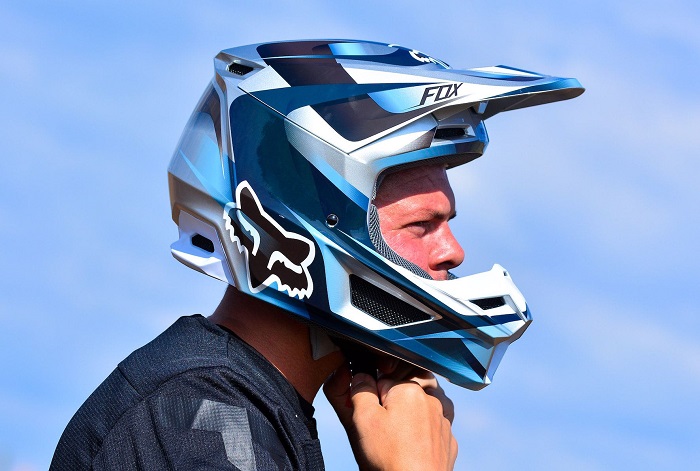Motocross is an energetic, entertaining sport. It’s also dangerous, which is one of the reasons it’s so attractive. Because even the most experienced riders might experience an accident, every level of rider must carry the greatest quality motocross gear available. The proper helmet can help prevent you from injury – and worse. No matter how daring you are, you should never jeopardise your safety.
The better protected you are, the more daring you can be on the track. Because it covers both your head and your face, the helmet may be the most vital motorbike equipment to invest in. Furthermore, a well-fitted helmet will keep you comfortable and dry while riding, making it easier to focus on the route without becoming distracted. This MX helmet buying guide will show you what makes motocross helmets different from other motorcycle helmet types and how to choose the best motocross helmet.
Why Are MX Helmets Different?

It’s critical to understand how a motocross helmet varies from other kinds of motorbike and bike helmets. The most significant difference is that MX helmets offer more room for your protective face gear, contributing to leading-edge safety while riding. The chin section of the helmet is also noteworthy, extended to protect you from any debris that may hit you while other riders navigate the course.
MX helmets feature specific venting as well, and many of them have crisp, eye-catching patterns. They have a liner that absorbs the energy from a crash or other form of impact. The energy from the collision will be compressed and dispersed by this liner, reducing the impact on your skull. Once you crush the liner, it’s no longer effective, meaning you must replace the helmet to ride safely.
What Are MX Helmets Made Of?
The materials, key components and technological advancements used in motocross helmets make them what they are: the best protective equipment piece in MX gear.
Materials
There are varying degrees of protection incorporated into every MX helmet on the market, with materials used to make the helmet significantly changing the level of overall protection. These usually are:
- Polycarbonate. A high-grade injected mould plastic that’s strong and lightweight, passing safety standards in Australia
- Fibreglass. A more robust finish with higher impact resistance but can be slightly heavier than other shell types.
- Composite carbon fibre, Kevlar and Tri Composite. A mixture of carbon fibre, kevlar, and fibreglass adds extra strength but reduces the weight of the outer shell.
- Carbon fibre. The best material for a modern-day helmet shell is super strong but extremely lightweight.
Key Components
Four key components make modern-day motocross helmets: the hard outer shell, EPS ‘Expanded Polystyrene foam’ Liner, inner foam padding/comfort Liner, and retention strap. The hard outer shell prevents penetration by pointed objects and provides structure to the inner liner. The dual-density EPS liner crushes during an impact, increasing the distance and period over which the head stops and reducing its deceleration.
Tech Advancements
MIPS, Bell Spherical, Bell FLEX, and Shoei MEDS are the latest technological advancements that make MX helmets even more protective. MIPS stands for Multi-directional Impact Protection System, a slip-liner found inside the helmet between comfort padding and EPS foam. Bell Spherical features a Ball-and-Socket design that redirects impact forces away from the brain, while FLEX is a three-layer impact liner designed to manage energy in low, mid, and high-speed impacts.
How to Pick the Best Motocross Helmet

Here are the most important aspects to consider while selecting your ideal motocross helmet.
Fit and comfort
Wearing a helmet isn’t enough for protection; it must fit correctly. Test the helmet’s fit before your first ride to avoid ill-fitting helmets. To do this, take off and put it back on, feel a snug fit, tighten the chin strap, and shake your head hard. Then, put one finger between the padding and your forehead, pull the helmet forward, and ask someone to roll it off your head. Wear the helmet for a few minutes, if possible, before deciding whether to keep or buy it. Don’t feel pressured to buy a helmet until you’ve tried it on, as 14% of fatal injuries occur when a helmet comes off the head during an accident.
Ventilation
That’s one of the most essential performance variables in a motocross helmet. You want one that properly channels cold air and has adequate vents to regulate temperature and prevent overheating.
Safety Certification
Most motocross helmets on the market must fulfil specific safety standards, but it’s advisable to double-check that it’s up to date with the newest rules in your country.
Ensure the helmet has a low-friction layer, such as a Mips® safety system, to help reduce rotational stress to the head during certain angled collisions.
Available Parts
We recommend buying a helmet from a prominent manufacturer to easily purchase replacement components if you break a visor, shatter a buckle, or lose a cheek pad.
Style

Today, there are plenty of excellent options for motocross helmets. Choose the style that will drive you to ride. Remember that while appearance is noteworthy, especially with bright, intense colours, fit is more vital. Choosing the appropriate fit should take precedence over appearance. Try on as many helmets as necessary to get one that fits right.
Cost
Regarding price, the time to hunt for a deal is not while purchasing a helmet. A good helmet shouldn’t be cheap; if it is, it may be missing a crucial safety element. For example, you want full-face coverage, which is more expensive (but also more protective) than a helmet with a bolt-on mouthguard. That way, you ensure maximum protection of your face and head from side or front impact with full facial coverage. Furthermore, you should never buy a used helmet or utilise someone else’s helmet.












